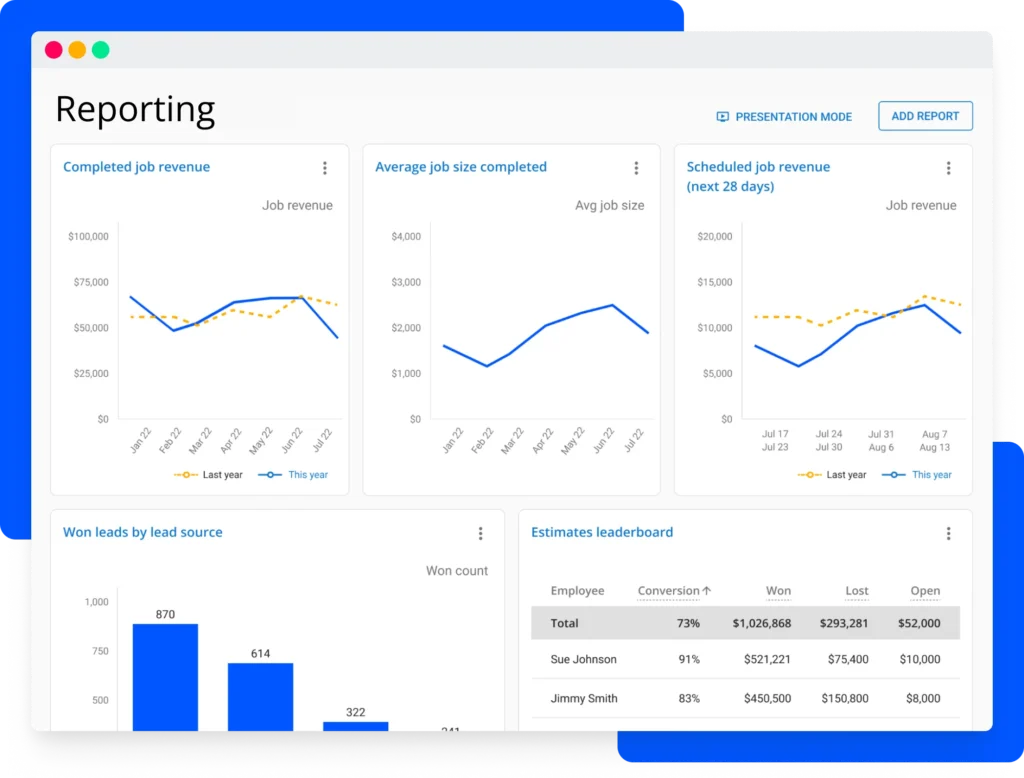Want to win more jobs with less effort?
Grow your business and send quick quotes with our home service software.

Starting your own HVAC company is an exciting and potentially lucrative venture, but without a clear roadmap, you can easily lose direction. That’s where a well-thought-out HVAC business plan comes in.
Think of your business plan as your HVAC company’s blueprint. It should serve as a document to guide your decisions, anticipate challenges, and, most importantly, ensure your business remains profitable as it grows. A business plan will also help you secure financing, giving investors and lenders a clear picture of your company’s goals and financial potential.
In this guide, we’ll walk you through exactly how to write one, step-by-step. You can also download our free HVAC business plan template to get started.
Pro tip: When meeting with potential investors or lenders, bring both your written plan and a condensed one-page summary for quick review.
Key takeaways:
Before we dive in, here are the main things you'll learn from this guide:
Start with a structure: A clear format helps potential investors and lenders understand your company’s vision.
Know your numbers: Accurate pricing, start-up costs, and revenue projections are essential.
Understand your market: Identify your target customers, research competitors, and outline how your HVAC business will stand out.
Create a growth plan: Set measurable goals for expansion, whether that’s hiring a team, adding new services, or scaling to new locations.
Use tools that work: Software like Housecall Pro streamlines operations so you can focus on what’s important.
Want more trade business insights like this? Sign up for our TradeWire newsletter to get the latest trends, tools, and trade talk straight to your inbox.
What to include in your HVAC business plan
Every business plan for an HVAC company should include:
Let’s walk through each section in detail.
Step 1: Cover page and table of contents
Your cover page is the first impression anyone will have of your HVAC business—whether it’s a potential partner, lender, or investor. It sets the tone for the rest of your business plan and shows you take your company seriously.
One small but often overlooked detail is the table of contents. Including one makes your plan much easier to navigate, especially if you’re sharing it digitally or printing copies for meetings. It shows organization and attention to detail, which are two qualities every successful business needs.
The cover page should include the following:
- Company name and logo
- Owner names
- Contact information (address, phone number, email, website)
- Date of the business plan
Pro tip: Even if you’re just starting, design a simple logo and use a professional email address (like john@yourcompany.com). Details like this help you stand out and build credibility from day one.
Step 2: Executive summary
Your executive summary is the snapshot of your HVAC business. It’s a quick overview that explains who you are, what you do, and where you’re headed. Keep it simple, clear, and confident. Highlight what makes your business different, like your team’s experience or the quality of your service.
Include:
- Your business name, location, and services
- Your mission statement (what problem you solve for customers)
- Short-term and long-term goals
- What makes your company stand out
Example:
At Hot & Cold HVAC, our mission is to deliver innovative HVAC solutions with a commitment to excellence and customer satisfaction. As a premier HVAC service provider in Denver, Colorado, we strive to establish the highest standards for reliability, efficiency, and professionalism in the industry.
Step 3: Company overview
This overview lays the foundation for your HVAC company business plan, such as who owns it, how it’s structured, and how and where it operates. It’s what lenders, partners, and even new employees will look at to understand how your business is set up and positioned to grow.
Here’s what to cover:
- Business structure: Sole proprietor, LLC, partnership, or corporation
- Ownership details: Who owns what percentage of the company
- Licenses and insurance: List all state and local licenses, liability insurance, and permits
- Service area: Define your territory (city, county, or region). Be specific; it’ll help when you start targeting local marketing campaigns.
Learn more: Check out our guide on how to make money in the HVAC business. It breaks down how to get started profitably and what to expect in your first year.
Step 4: Management team
This section highlights who’s behind your HVAC business and why they’re qualified to make it succeed. Whether you’re running a one-person shop or building a small crew, this is your chance to showcase the experience, leadership, and skill that will drive your company forward.
Be sure to include:
- Owners and founders
- General manager or operations lead
- Lead technicians or installers
- Office or dispatch managers
Include short bios that highlight each person’s experience and credentials. For example:
“John Smith, Founder and Lead Technician, has 12 years of residential HVAC installation experience and EPA certification. John oversees all service operations and customer satisfaction.”
Even if you’re starting out as a one-person operation, mention your plans to grow. Outline which roles you’ll hire first, like an admin to handle calls or a junior tech to double your job capacity.
Get In Touch: 858-842-5746
Let us earn your trust
On average, Pros increase monthly revenue generated through Housecall Pro by 50% after their first year.
See plan options and feature breakdown on our pricing page.
Step 5: HVAC services list
A thorough services list will help customers understand your offerings and lenders see where your revenue will come from. Detail all the HVAC services your business will provide. Be specific, since it will help you define your pricing and marketing later. If you offer niche or specialized services, like energy-efficient retrofits or commercial refrigeration, be sure to highlight those.
Include common HVAC services, such as:
- HVAC system installation (residential and/or commercial)
- Seasonal maintenance and tune-ups
- Emergency repairs
- Duct cleaning, sealing, and replacement
- Thermostat and smart home integrations
- Indoor air quality upgrades
Pro tip: Consider offering service agreements or maintenance plans. They create recurring revenue and help smooth out the slower seasons.
Step 6: Operations plan
Your operations plan explains how your HVAC business runs day-to-day, from scheduling jobs to completing service calls and invoicing. This section shows lenders that your company is organized and ready to handle steady growth.
Outline the key parts of your daily workflow:
- Scheduling and dispatch: How jobs are booked, assigned, and tracked.
- Tools and equipment: What you’ll use to get the work done: vehicles, diagnostic tools, safety gear, and software.
- Suppliers and inventory: Who you purchase parts and materials from, and how you manage restocking.
- Customer communication: How you’ll handle quotes, job updates, and follow-ups.
Pro tip: Use field service management software like Housecall Pro to keep scheduling, dispatching, invoicing, and payments all in one place. It cuts down on paperwork and saves time, so you can focus on taking more jobs and building your customer base.
Step 7: HVAC pricing
Pricing your services correctly is key to staying competitive and profitable. Use this section to explain your pricing strategy and how you’ll maintain healthy margins.
Cover the following:
- Pricing model: Will you charge hourly, use flat-rate pricing, or price by project type?
- Cost breakdown: Include labor, materials, fuel, vehicle expenses, and overhead.
- Profit goals: Set a target profit margin for each service category.
- Competitor research: Compare your rates to others in your area to stay competitive without undercharging.
The averages shown below reflect midrange pricing for standard residential HVAC systems in the U.S. Your actual rates may vary depending on your market, experience, and service mix.
| HVAC Service | Typical Range* | Notes |
| HVAC installation | $5,000–$12,000 | Full system replacement, including parts and labor |
| AC unit installation | $3,500–$7,500 | Central air conditioning system |
| Furnace replacement | $3,000–$6,500 | Includes gas or electric furnace installation |
| HVAC maintenance / tune-up | $75–$200 | Annual or seasonal service |
| HVAC repair | $150–$600 | Average repair visit, depending on the issue |
| Ductwork Installation / replacement | $2,500–$6,000 | Based on home size and duct type |
*Data sourced from HomeGuide.
Don’t guess your prices. Use data and real costs to calculate your margins. Our HVAC pricing guide helps you accurately price jobs while staying competitive.
Step 8: Industry analysis
An industry analysis shows you understand the HVAC market and where your business fits in. It’s especially important if you’re seeking funding or partnerships to prove that you’ve done your homework.
Summarize the current state of the HVAC industry, key trends, and local market conditions that could affect your business.
- Market trends: Growth in smart HVAC systems or sustainable technology.
- Target market: Homeowners, landlords, builders, or small businesses.
- Competitors: A few local competitors, and what sets you apart.
- Outlook: The U.S. HVAC industry is projected to grow steadily over the next several years.
Step 9: Marketing strategy
Your HVAC marketing strategy outlines how you’ll attract new customers and retain existing ones. Lenders and partners want to see that you know who your customers are, how they make buying decisions, and what channels you’ll use to connect to them.
- Target audience: Describe your ideal customer (e.g., homeowners, builders, or property managers) and what problems your HVAC services will solve for them.
- Brand positions: Explain how your company stands out. For example, same-day service, transparent pricing, or energy-efficient solutions.
- Marketing channels: Outline how you’ll reach and convert customers. For example, through local SEO, Google Business Profile, paid ads, email, or direct mail. Mention how you’ll track performance (leads, traffic, or reviews) to refine your strategy over time.
- Customer retention plan: Explain how you’ll maintain relationships through maintenance plans, reminders, or referral programs.
- Budget overview: Estimate how much of your revenue you’ll allocate to marketing, even if it’s a rough percentage.
Step 10: Employee planning
Your employees are the backbone of your HVAC company. Even if you’re starting solo, it’s important to plan how your team will grow. This shows that you’re thinking strategically about staffing, training, and maintaining service quality as your workload increases
Outline what roles you’ll need filled as the business grows. That could be a dispatcher to manage calls, a junior technician to assist with installations, or an office manager to handle administrative tasks.
- Current staff: List your current team, including technicians, admin, and dispatch roles.
- Future hires: Identify upcoming positions, such as an additional tech, installer, or office manager.
- Training and onboarding: Explain how you’ll prepare new employees with certifications, mentorship, and safety programs.
- Compensation: Note whether you’ll pay hourly, by salary, or with performance-based incentives.
Step 11: Financial planning
Your financial plan is perhaps the most important part of your HVAC business plan. It shows how your company makes money, how you manage expenses, and when you expect to turn a profit. A detailed financial plan gives lenders confidence in your ability to operate sustainably and scale over time.
Use realistic estimates to make sure you’re setting proper expectations when including the following:
- Startup cost: Tools, trucks, marketing, and licensing.
- Operating expenses: Payroll, fuel, rent, and supplies
- Revenue projections: Expected income from installations, repairs, and maintenance plans.
- Break-even analysis: When your income covers your expenses.

Step 12: Appendix
The appendix includes any materials that support your HVAC business plan. It adds credibility by showing that you have all the proper documentation and accreditations in place, proving that your company is legitimate, compliant, and ready to operate.
It also makes it easy for lenders or partners to verify key information, such as your licenses, insurance, or certifications.
Include:
- Business licenses, permits, and insurance policies
- Certifications and training records
- Resumes for key team members
- Vendor or supplier agreements
- Photos of completed projects or branded vehicles
- Sample marketing materials
How Housecall Pro can help you grow your HVAC business
Once your HVAC business plan is ready, you’ll need the right tools to put it into action. That’s where Housecall Pro comes in.
Our HVAC software helps HVAC business owners:
- Schedule and dispatch jobs in one app
- Send estimates and invoices on the spot
- Collect payments in person or online
- Automate reviews and marketing to bring customers back
- Track revenue and expenses with easy job costing
Start your free 14-day trial to see how Housecall Pro can streamline your operations, save you time, and help your HVAC business grow faster from day one.
Frequently asked questions
-
What should be included in an HVAC business plan?
-
An HVAC business plan should include your company overview, list of services, pricing strategy, operations plan, marketing approach, staffing, and financial projections.
-
How much does it cost to start an HVAC business?
-
The cost to start an HVAC business can be between $10,000 and $50,000, depending on your equipment, vehicle, licensing, and marketing expenses.
-
How do HVAC businesses make money?
-
HVAC businesses make money through system installations, repairs, and maintenance contracts. Offering service plans helps create steady, recurring income.
-
Are HVAC businesses profitable?
-
Yes, HVAC businesses are profitable. Most companies earn between 15% and 35% profit margins, depending on pricing, efficiency, and market demand.
-
Do I need a business plan to start an HVAC business?
-
Yes, you need a business plan to start an HVAC business. It helps you plan for growth, secure financing, and keep your operations organized from day one.





